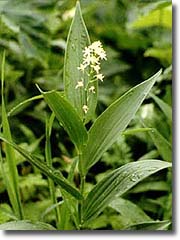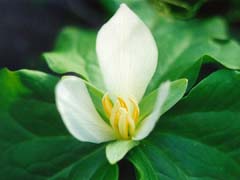Smilacine stellata
var. sessilifolia:
Slim Solomon's Seal
(Starry Solomon's Seal)
Liliaceae (Lily Family)
Flowers: White, six petals, star-shaped on single pedicels at
top of stem.
Blooms: February - April.
Leaves: Narrow ("slim"), parallel veined, alternate
and semi-clasping along stem, 3 -6" long.
Fruit/Seeds: Red-purple berries.
Location: Damp slopes along trails.
Status: Native - Common. |

Smilacine stellata var sessilifolia
400x600 JPEG - 44K |
Further description & Comment: 1 - 3 feet tall, single stems
that grow each year from a ground-level network of creeping rhizomes and
succulent rootlets.
The main difference between Smilacine
racemosa (Fat/False Solomon's Seal) and Smilacine stellata
(Slim/Starry Solomon's Seal) is apparent (I hope) in the
pictures: one's fat and the other's slim. There are, of course, substantial
differences in the leaves, flowers, and general plant structures of the
two species, but in the field it is the chunkiness and slimness that immediately
distinguishes the two.
Common Name Note: The "real" Solomon's Seal is an flower
in the Lily Family that grows in the Eastern United States and is of the
Polygonatum. genus. Hence the name "False" Solomon's Seal
for S. racemosa., probably bestowed by some expatriated New England
botanist. This convention of "False this-or-that" appears to be
common in Liliaceae (False Lily-of-the-Valley, etc.)
The name "Solomon's Seal" refers to a mystic icon, two interlocked
triangles in the shape of a six pointed star (often with one triangle white,
the other black) representing the union of soul and body. As an amulet,
it is said to ward off fever and other diseases. Supposedly, the upright
branch shoot leave this mark on the underground rootstock, which is dug
up for medicinal uses (see below). Or it could be because of the shape of
their flowers (6 - pointed stars) or because of their medicinal qualities
in general, or both, but I'm not sure. |
The roots of both species, but primarily Smilacine racemosa, are used in herbal medicines
as anti-imflammatories and astringents. The fresh chopped root, cooked with
honey, makes an excellent cough syrup. Fresh Smilacine root,
ground up with a rock, can be an effective and soothing field poultice for
stings, bites, burns, and small localized Poison Oak or Stinging
Nettle - Stinging
Phacelia rashes.
Can't work any worse than Mugwort. |
